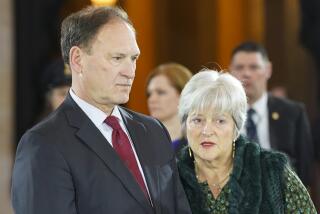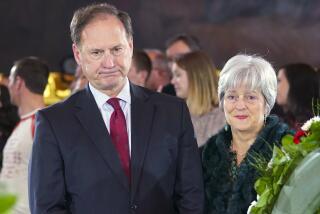Life Beyond the Bench for High Court Justices
WASHINGTON — The Supreme Court justices do not spend all their time indoors squinting over legal briefs, or so they are quick to report.
Take Justice Antonin Scalia, the combative conservative, for instance. When he’s not firing verbal shots at his colleagues over what he views as flawed reasoning, he likes to take aim at deer, ducks and turkeys.
In a May interview with GQ magazine, the former University of Chicago law professor said his favorite magazine is “Ducks Unlimited.” On free weekends, he said he goes to southern Louisiana, Illinois or Long Island, N.Y., to hunt. He keeps a freezer full of game at his suburban Virginia home.
Scalia’s ideal Saturday morning, he said, is to be crouching, cold and shivering, in a damp duck blind, his gun ready, waiting for a few birds to fly into range.
Justice Stephen G. Breyer is a fisherman. In May, he became the first Supreme Court justice to travel to Alaska to speak to the state bar convention. He also had time for a fishing trip.
The next day, the Ketchikan Daily News featured a front page photo of the justice proudly displaying a 28-pound king salmon.
“You seem to have had trouble having Supreme Court justices come to Alaska,” he told the lawyers’ group. “You won’t in the future.”
To make sure the message got through, he took the iced salmon back to Washington, where it was served to the justices at their next luncheon conference.
Chief Justice William H. Rehnquist is an amateur historian. He has written books on the history of impeachments and speaks often about framers of the Constitution and the early history of the Supreme Court.
But history is more than the stories of great men, as he noted recently.
Rehnquist, whose ancestors were Swedish, agreed to speak to the Swedish Colonial Society’s annual luncheon in Philadelphia in April. He lauded Swedes as being “nothing if not good genealogists.
“Actually, [they] were so good that I found out more than I wanted about my Swedish ancestors,” the chief justice said. “One of them in the 17th century was executed for having embezzled funds from an estate for which he was the steward.”
Ruth Bader Ginsburg is an opera fan, Anthony M. Kennedy a Shakespeare buff. And Sandra Day O’Connor, like Justice John Paul Stevens, plays tennis and golf. David H. Souter is a devoted runner and jogs six miles nearly every evening. He spends much of his summer hiking in his native New Hampshire.
Justice Clarence Thomas, who turned 53 on Thursday, is still by far the youngest of the nine and used to speak fondly of riding on his motorcycle and in his black Corvette. But he is showing his age as well. He has been telling friends he and his wife are looking forward to traveling the roadways this summer in his new recreational vehicle.
In mid-July, O’Connor and Breyer are traveling together, and not just to the usual legal conferences. They are speaking at the annual meeting of judges at the U.S. 9th Circuit Conference in Montana, but then plan to visit Indian reservations.
The justices are often amused at how they are mistaken for one another. Lawyers during oral arguments sometimes mix up the two women on the court, calling Ginsburg “Justice O’Connor” and referring to O’Connor as Ginsburg.
During the Florida election case, attorney Joseph Krock referred to Souter as “Justice Breyer.” And apparently, he is not alone in confusing the two. Both say they have been mistaken for the other.
Breyer was at his alma mater Stanford University last month to attend his son Michael’s graduation and agreed to speak to a group of students there. Afterward, a young woman came up to praise his comments. “Thank you for being here, Justice Souter,” she told an amused Breyer.
More to Read
Get the L.A. Times Politics newsletter
Deeply reported insights into legislation, politics and policy from Sacramento, Washington and beyond. In your inbox three times per week.
You may occasionally receive promotional content from the Los Angeles Times.











